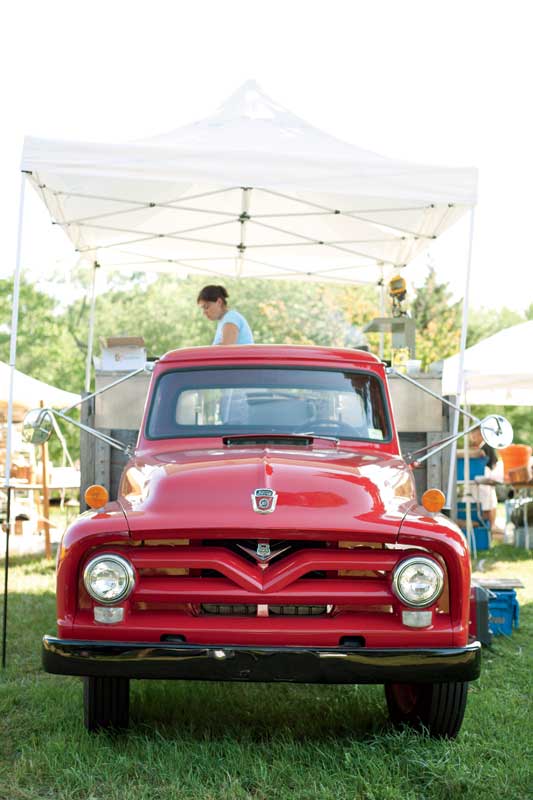Dinners at the Farm: Celebrating the Land
During summer evenings in Connecticut, a farmer’s field turns into an elegant harvest dinner for guests under the stars.

A rumble of laughter rises from the tent at White Gate Farm.
A handful of people lounge around a table, picking at the last of the bruschetta and passing around half-empty bottles of San Pellegrino. The Connecticut sun is hot, and this meal is a welcome pause in a long workday. But their boss interrupts their banter with a quick look at his clipboard. “Duck breast,” says Jonathan Rapp, turning to his second-in-command, a young chef named Thomas Peterlik. “When do we want to sear up the duck breast?”
The table quiets down as the conversation turns back to business. Everyone knows that this lunch is their last break before a night of work that will likely stretch into the early morning. And if Rapp is less jovial than the rest, it’s because tonight he must perform a very difficult magic trick: In a single evening, he will conjure a four-star restaurant from a field of crickets and wild grasses.
The matter-of-factly named “Dinners at the Farm” series began four years ago when Rapp, chef and owner of the acclaimed River Tavern in Chester, Connecticut, and co-founders Chip Dahlke and Drew McLachlan envisioned bringing fine dining right to the fields. “We wanted to cook directly at the source,” Rapp explains. “We didn’t have lofty intentions.” Though Dahlke and McLachlan have both moved on to other projects, Rapp has continued to expand on the original idea. He now produces 16 dinners throughout the growing season at two Connecticut farms: here at White Gate in East Lyme and at Barberry Hill in Madison. As always, the menu changes to highlight whatever fare is fresh that day. And Rapp now shares the proceeds with three like-minded organizations: CitySeed, the Connecticut Farmland Trust, and the Working Lands Alliance.
Rapp, whose sturdy frame and tanned arms make him appear more farmer than chef, starts his day long before his 170 guests arrive, usually by picking up that day’s produce, plus fresh bread from the bakery at the Copper Beech Inn, ducks sourced from a one-woman operation called Soeltl Farm, and locally caught fish from Gambardella’s or Stonington Seafood Harvesters. “As cooks, we’re very in touch with where our food comes from,” Rapp says. “People leave these dinners excited; chances are next weekend they might think twice about going to the supermarket, and they’ll go to their local farmers’ market instead.”
With lunch put away, Rapp’s small army of chefs kicks into action. Rapp climbs atop his mobile kitchen–a converted 1955 firetruck outfitted with a six-burner stove and a grill–while Peterlik takes command of the rest of the staff in the prep tent. A generator roars to life, and burners are hooked up to portable propane tanks. Everyone’s attention turns to chopping, pureeing, boiling, and seasoning. The jokes and banter thin out as the sun begins to sink.
The first guests arrive just before dusk. They’re a mixed bunch, apparently unable to agree on the proper attire; some are dressed for the farm and others for the dinner. Among the visitors are a young threesome who look as though they’ve just trained up from SoHo; a retired Connecticut couple in chinos; and a group of women enjoying a girls’ night out in mud boots.
The white wooden fence throws long shadows across the lane as the guests stroll past White Gate’s artfully designed farm stand. To their left, a neatly manicured lawn flows over low hills, and freshly painted barns reflect the last of the day’s light. It’s impossibly idyllic–and a clear sign that this small, organic operation was chosen as much for its beauty as for the quality of its vegetables.
The visitors pass through a break in a stone wall and enter Rapp’s creation. Three pristinely white tents sit in the quiet field, pennants fluttering from their masts in the lazy summer breeze. The diners are greeted with tonight’s specialty cocktail, a peach mojito made with this season’s ripe local fruit. Appetizers in the form of a rustic pate on crostini and crispy squash-blossom tempura are passed right from the open-air kitchen. The guests break off in groups of threes and fours, and the evening air fills with conversation.
As the sun sets, everyone finds a seat at the family-style tables under the tents. The ring of a knife on a wineglass cuts through the din, and everyone quiets. Rapp welcomes everyone and offers a toast. “To work all day in this beautiful field with food grown right here …” he says, “… there’s no more glorious place to be.”
With that, the waiters stream in with course after flawless course. The food looks as though it must have been plated in a hushed kitchen: understated and refined. A chorus of crickets chirp around the tents as the diners savor their risotto with zucchini flowers, lightly poached fluke over smashed purple potatoes, and roasted duck breast served with spaetzle and the season’s first apples. The arrival of dessert–a buttermilk panna cotta with honey-poached peaches–is greeted with cheers under the tents.
As the night draws to a close, Rapp reflects on his work. “People expect great food from a really good restaurant,” he says. “But when you’re sitting in a field under the stars, the experience is heightened, I think.”
For the 2011 schedule, go to: dinnersatthefarm.com. View a video of one of Chef Rapp’s farm dinners, and get his recipe for buttermilk panna cotta with honey-poached peaches.


